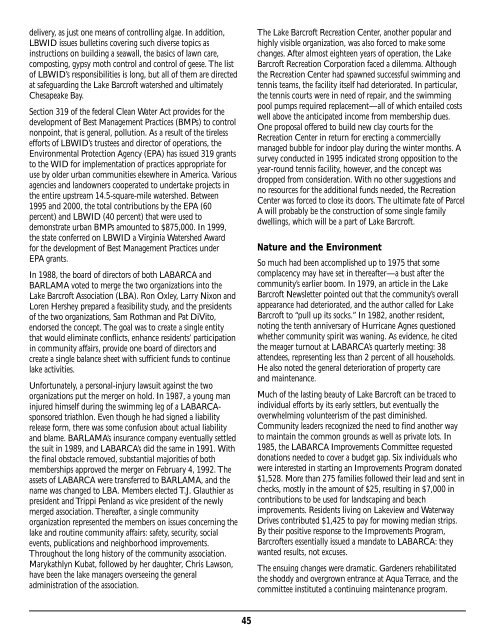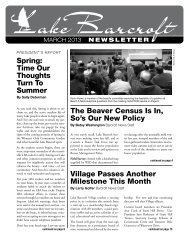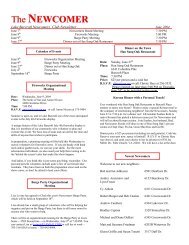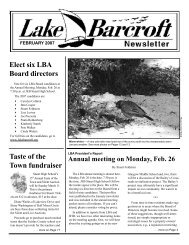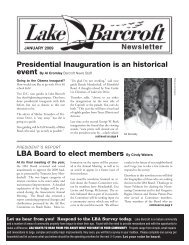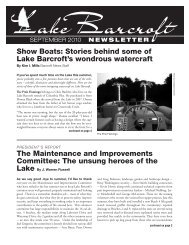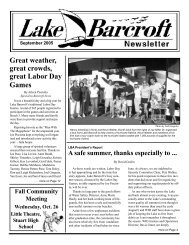Lake Barcroft History Book
Lake Barcroft History Book
Lake Barcroft History Book
You also want an ePaper? Increase the reach of your titles
YUMPU automatically turns print PDFs into web optimized ePapers that Google loves.
delivery, as just one means of controlling algae. In addition,<br />
LBWID issues bulletins covering such diverse topics as<br />
instructions on building a seawall, the basics of lawn care,<br />
composting, gypsy moth control and control of geese. The list<br />
of LBWID’s responsibilities is long, but all of them are directed<br />
at safeguarding the <strong>Lake</strong> <strong>Barcroft</strong> watershed and ultimately<br />
Chesapeake Bay.<br />
Section 319 of the federal Clean Water Act provides for the<br />
development of Best Management Practices (BMPs) to control<br />
nonpoint, that is general, pollution. As a result of the tireless<br />
efforts of LBWID’s trustees and director of operations, the<br />
Environmental Protection Agency (EPA) has issued 319 grants<br />
to the WID for implementation of practices appropriate for<br />
use by older urban communities elsewhere in America. Various<br />
agencies and landowners cooperated to undertake projects in<br />
the entire upstream 14.5-square-mile watershed. Between<br />
1995 and 2000, the total contributions by the EPA (60<br />
percent) and LBWID (40 percent) that were used to<br />
demonstrate urban BMPs amounted to $875,000. In 1999,<br />
the state conferred on LBWID a Virginia Watershed Award<br />
for the development of Best Management Practices under<br />
EPA grants.<br />
In 1988, the board of directors of both LABARCA and<br />
BARLAMA voted to merge the two organizations into the<br />
<strong>Lake</strong> <strong>Barcroft</strong> Association (LBA). Ron Oxley, Larry Nixon and<br />
Loren Hershey prepared a feasibility study, and the presidents<br />
of the two organizations, Sam Rothman and Pat DiVito,<br />
endorsed the concept. The goal was to create a single entity<br />
that would eliminate conflicts, enhance residents’ participation<br />
in community affairs, provide one board of directors and<br />
create a single balance sheet with sufficient funds to continue<br />
lake activities.<br />
Unfortunately, a personal-injury lawsuit against the two<br />
organizations put the merger on hold. In 1987, a young man<br />
injured himself during the swimming leg of a LABARCAsponsored<br />
triathlon. Even though he had signed a liability<br />
release form, there was some confusion about actual liability<br />
and blame. BARLAMA’s insurance company eventually settled<br />
the suit in 1989, and LABARCA’s did the same in 1991. With<br />
the final obstacle removed, substantial majorities of both<br />
memberships approved the merger on February 4, 1992. The<br />
assets of LABARCA were transferred to BARLAMA, and the<br />
name was changed to LBA. Members elected T.J. Glauthier as<br />
president and Trippi Penland as vice president of the newly<br />
merged association. Thereafter, a single community<br />
organization represented the members on issues concerning the<br />
lake and routine community affairs: safety, security, social<br />
events, publications and neighborhood improvements.<br />
Throughout the long history of the community association.<br />
Marykathlyn Kubat, followed by her daughter, Chris Lawson,<br />
have been the lake managers overseeing the general<br />
administration of the association.<br />
45<br />
The <strong>Lake</strong> <strong>Barcroft</strong> Recreation Center, another popular and<br />
highly visible organization, was also forced to make some<br />
changes. After almost eighteen years of operation, the <strong>Lake</strong><br />
<strong>Barcroft</strong> Recreation Corporation faced a dilemma. Although<br />
the Recreation Center had spawned successful swimming and<br />
tennis teams, the facility itself had deteriorated. In particular,<br />
the tennis courts were in need of repair, and the swimming<br />
pool pumps required replacement—all of which entailed costs<br />
well above the anticipated income from membership dues.<br />
One proposal offered to build new clay courts for the<br />
Recreation Center in return for erecting a commercially<br />
managed bubble for indoor play during the winter months. A<br />
survey conducted in 1995 indicated strong opposition to the<br />
year-round tennis facility, however, and the concept was<br />
dropped from consideration. With no other suggestions and<br />
no resources for the additional funds needed, the Recreation<br />
Center was forced to close its doors. The ultimate fate of Parcel<br />
A will probably be the construction of some single family<br />
dwellings, which will be a part of <strong>Lake</strong> <strong>Barcroft</strong>.<br />
Nature and the Environment<br />
So much had been accomplished up to 1975 that some<br />
complacency may have set in thereafter—a bust after the<br />
community’s earlier boom. In 1979, an article in the <strong>Lake</strong><br />
<strong>Barcroft</strong> Newsletter pointed out that the community’s overall<br />
appearance had deteriorated, and the author called for <strong>Lake</strong><br />
<strong>Barcroft</strong> to “pull up its socks.” In 1982, another resident,<br />
noting the tenth anniversary of Hurricane Agnes questioned<br />
whether community spirit was waning. As evidence, he cited<br />
the meager turnout at LABARCA’s quarterly meeting: 38<br />
attendees, representing less than 2 percent of all households.<br />
He also noted the general deterioration of property care<br />
and maintenance.<br />
Much of the lasting beauty of <strong>Lake</strong> <strong>Barcroft</strong> can be traced to<br />
individual efforts by its early settlers, but eventually the<br />
overwhelming volunteerism of the past diminished.<br />
Community leaders recognized the need to find another way<br />
to maintain the common grounds as well as private lots. In<br />
1985, the LABARCA Improvements Committee requested<br />
donations needed to cover a budget gap. Six individuals who<br />
were interested in starting an Improvements Program donated<br />
$1,528. More than 275 families followed their lead and sent in<br />
checks, mostly in the amount of $25, resulting in $7,000 in<br />
contributions to be used for landscaping and beach<br />
improvements. Residents living on <strong>Lake</strong>view and Waterway<br />
Drives contributed $1,425 to pay for mowing median strips.<br />
By their positive response to the Improvements Program,<br />
<strong>Barcroft</strong>ers essentially issued a mandate to LABARCA: they<br />
wanted results, not excuses.<br />
The ensuing changes were dramatic. Gardeners rehabilitated<br />
the shoddy and overgrown entrance at Aqua Terrace, and the<br />
committee instituted a continuing maintenance program.


